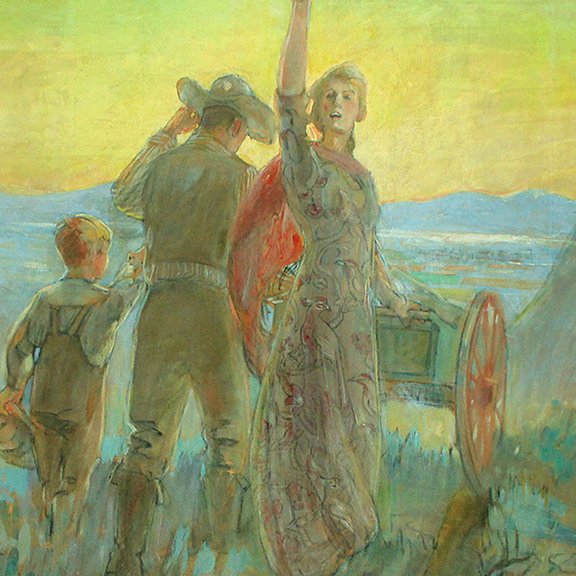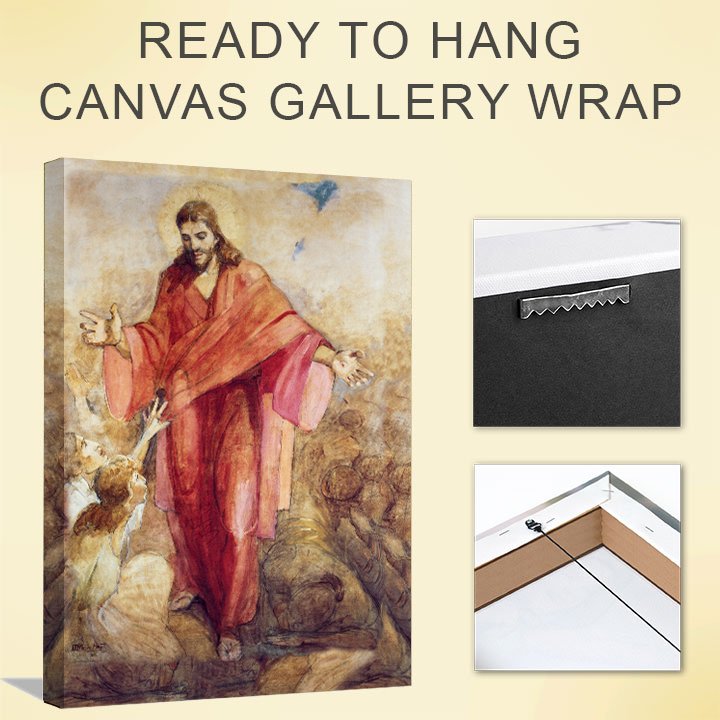Shouting Hosannah by Minerva Teichert (c. 1935)
The sense of excitement and relief the handcart pioneers must have felt approaching the the Salt Lake Valley shows in the beaitufl painting. A woman turning back to raise a handkerchief to those traveling Latter-day Saint handcart pioneers behind. This gesture hold deep meaning to Latter-day Saints everywhere. The colors are bold and and the expression is remarkable.
More About Shouting Hosannah
Minerva Teichert created dozens of murals in public buildings all around Utah; none of them were funded through the WPA. While most of her murals were western themed, there were many with “crossover” meanings. Those who knew Mormon history would recognize the story blended within a scene of wagons and oxen. Those who didn’t know the local history saw her murals as beautiful scenes of the American west. In 1935 the Church of Jesus Christ of Latter-day Saints commissioned Minerva Teichert to paint an over-sized vertical mural specifically for the Presidential suite in the Hotel Utah. The mural was intentional created so that it could be removed or moved. At almost 12 feet tall, it was an impressive part of the suite. Eventually the mural was converted to a framed piece of art and put on display in Salt Lake’s Hotel Temple Square. Originally Titles Zion Ho! - The Handcart Pioneers, it’s now known as simply Handcart Pioneers. Much her Mural work was done during the Great Depression. Minerva said her main artistic outlet was her murals. Her grandson said at her funeral that Minerva would paint in one room and cook dinner in the kitchen. She would add strokes to paintings between between chores. “She was a multitasker—big time,” says her grandson. “She’d be cooking at the stove and walk around [the corner] and put some brush strokes on the painting.”
More About Minerva Teichert
Minerva Teichert was an artist whose works ranged from western American subjects to many religious paintings primarily depicting the history of the Latter-day Saint movement. This includes Minerva’s several works requested by the Church that were used to illustrate the stories using Book of Mormon art. She is also well known for the many murals she painted in public and private buildings scattered throughout Wyoming, Idaho and Utah. She was born Minerva Kohlhepp in 1888 in North Ogden, Utah. Minerva was the second of ten children and spent most of the first half of her life doing just as much farm work as she did painting. She studied under famous artists like Robert Henri at the Art Institute of Chicago and Art Students League of New York. When she was 29 years old, Minerva Kohlhepp married Herman Teichert on September 15, 1917. However, only one year after their wedding, World War One broke out and Herman left for battle. Although Minerva traveled with Herman throughout his boot camp training and transfers, she was eventually forced to bid farewell and stayed at home with their newborn baby son. During the early years of their marriage, everything was in short supply because of the war, so Minerva Teichert would paint on scraps of wood and paper because there simply wasn’t enough money to buy art supplies. Fortunately, Herman returned home after the war and the couple went on to have four more children. Minerva and Herman spent most of their lives on a ranch in Cokeville, Wyoming. Much of Minerva Teichert art can also be found by searching for LDS art, LDS church pictures, and Mormon art; even though these are not official names of the Church of Jesus Christ of Latter-day Saints.










